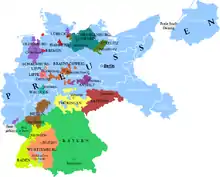Prussian Landtag elections in the Weimar Republic
The Free State of Prussia held elections to its Landtag between 1919 and 1933.[1] From 1919 through 1928, these elections gave a plurality to the SPD. In 1932 and 1933, the NSDAP (Nazi Party) won pluralities, generally in line with the rest of Germany.[2][3] The Landtag subsequently was formally abolished as a result of the "Law on the Reconstruction of the Reich" of 30 January 1934 which replaced the German federal system with a unitary state.[4]
| Year | 1919 | 1921 | 1924 | 1928 | 1932 | 1933 | ||||||
|---|---|---|---|---|---|---|---|---|---|---|---|---|
| Party | % | Seats | % | Seats | % | Seats | % | Seats | % | Seats | % | Seats |
| SPD | 36.4 | 145 | 25.9 | 109 | 24.9 | 114 | 29.0 | 137 | 21.2 | 94 | 16.6 | 80 |
| Zentrum | 22.3 | 94 | 17.9 | 76 | 17.6 | 81 | 15.2 | 71 | 15.3 | 67 | 14.1 | 68 |
| DDP/DStP | 16.2 | 65 | 5.9 | 26 | 5.9 | 27 | 4.4 | 21 | 1.5 | 2 | 0.7 | 3 |
| DNVP | 11.2 | 48 | 18.0 | 76 | 23.7 | 109 | 17.4 | 82 | 6.9 | 31 | 8.9 | 43 |
| USPD | 7.4 | 24 | 6.4 | 27 | ||||||||
| DVP | 5.7 | 23 | 14.0 | 59 | 9.8 | 45 | 8.5 | 40 | 1.5 | 7 | 1.0 | 3 |
| DHP | 0.5 | 2 | 2.4 | 11 | 1.4 | 6 | 1.0 | 4 | 0.3 | 1 | 0.2 | 2 |
| SHBLD | 0.4 | 1 | ||||||||||
| KPD | 7.5 | 31 | 9.6 | 44 | 11.9 | 56 | 12.3 | 57 | 13.2 | 63 | ||
| WP | 1.2 | 4 | 2.4 | 11 | 4.5 | 21 | ||||||
| Polen | 0.4 | 2 | 0.4 | 2 | ||||||||
| NSFP | 2.5 | 11 | ||||||||||
| NSDAP | 1.8 | 6 | 36.3 | 162 | 43.2 | 211 | ||||||
| CNBL | 1.5 | 8 | ||||||||||
| VRP | 1.2 | 2 | ||||||||||
| DVFP | 1.1 | 2 | ||||||||||
| CSVD | 1.2 | 2 | 0.9 | 3 | ||||||||
| Total seats | 402 | 421 | 450 | 450 | 423 | 476 | ||||||

Prussia in the Weimar Republic shown in light blue.
.PNG.webp)
Chart of election results.
References
- "Landtagswahlen Freistaat Preußen 1919–1933".
- Orlow, Dietrich (2009). Weimar Prussia, 1918-1925: The Unlikely Rock of Democracy. Pittsburgh, PA: University of Pittsburgh Press. p. 19. ISBN 9780822984962.
- Craig, Gordon A. (1984). The End of Prussia. Madison, WI: University of Wisconsin Press. ISBN 9780299097349.
- Wells, Roger H. (April 1936). "The Liquidation of the German Länder". The American Political Science Review. American Political Science Association. 30 (2): 351–352. doi:10.2307/1947263. JSTOR 1947263. S2CID 147621323.
This article is issued from Wikipedia. The text is licensed under Creative Commons - Attribution - Sharealike. Additional terms may apply for the media files.